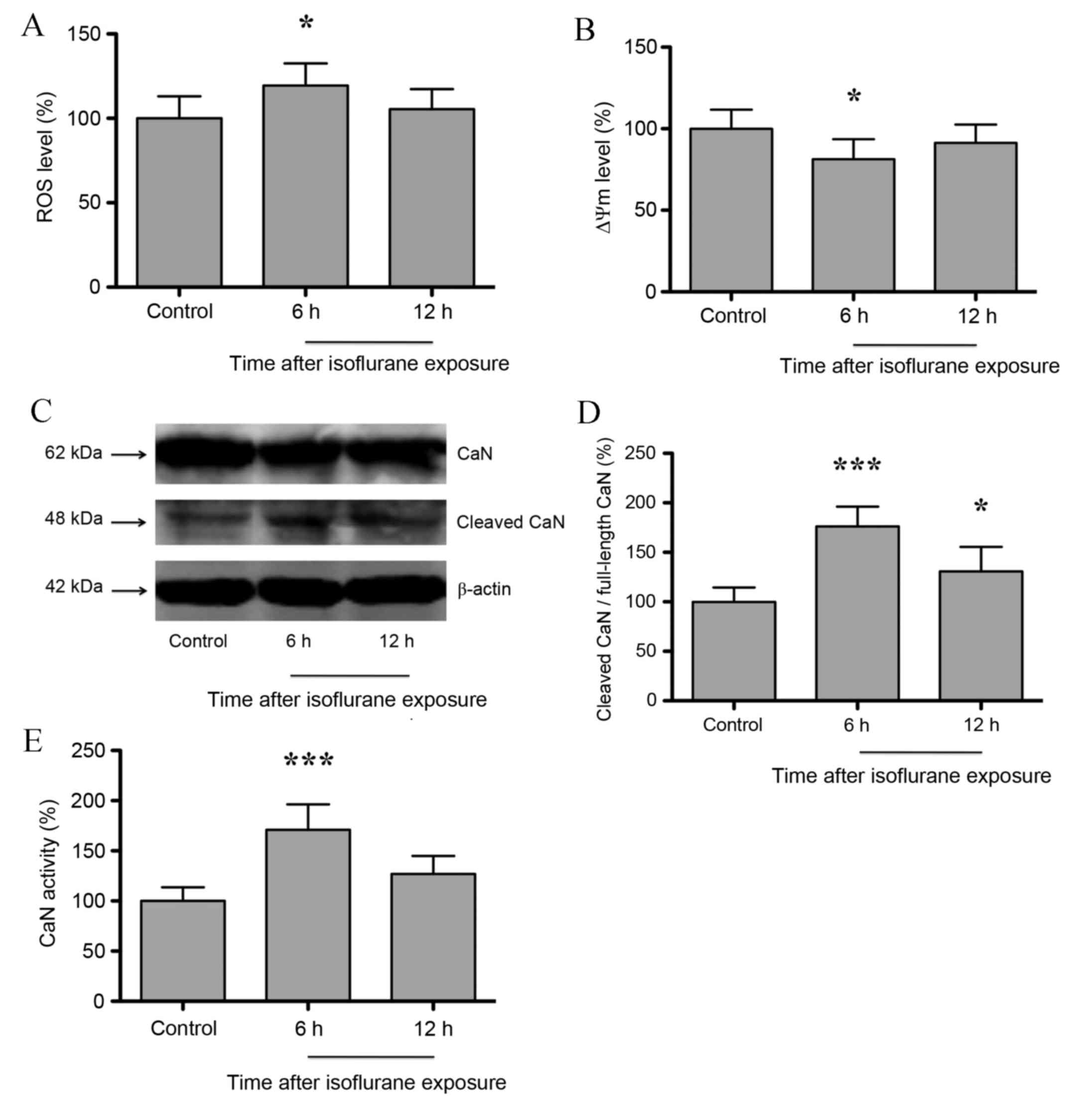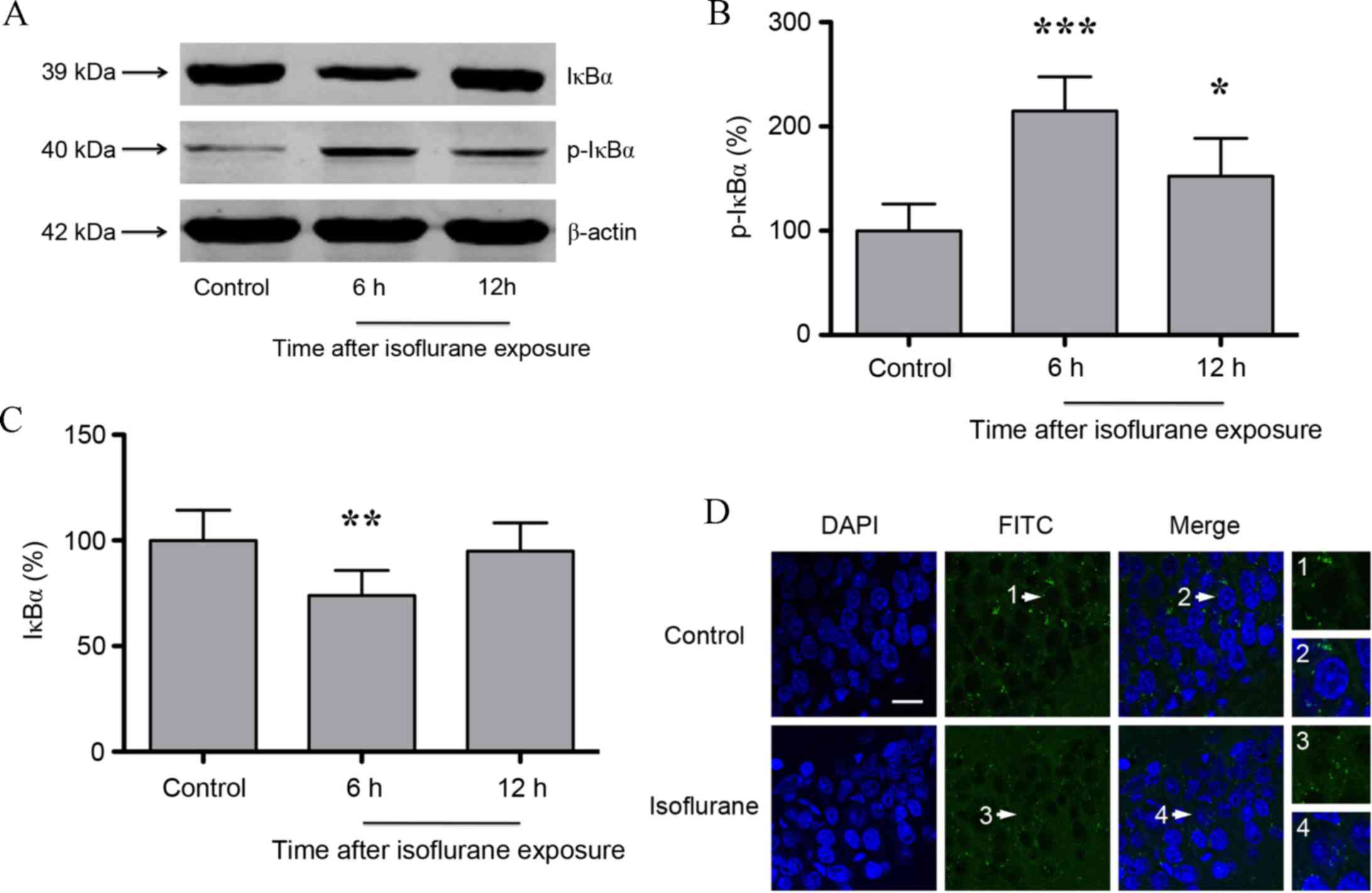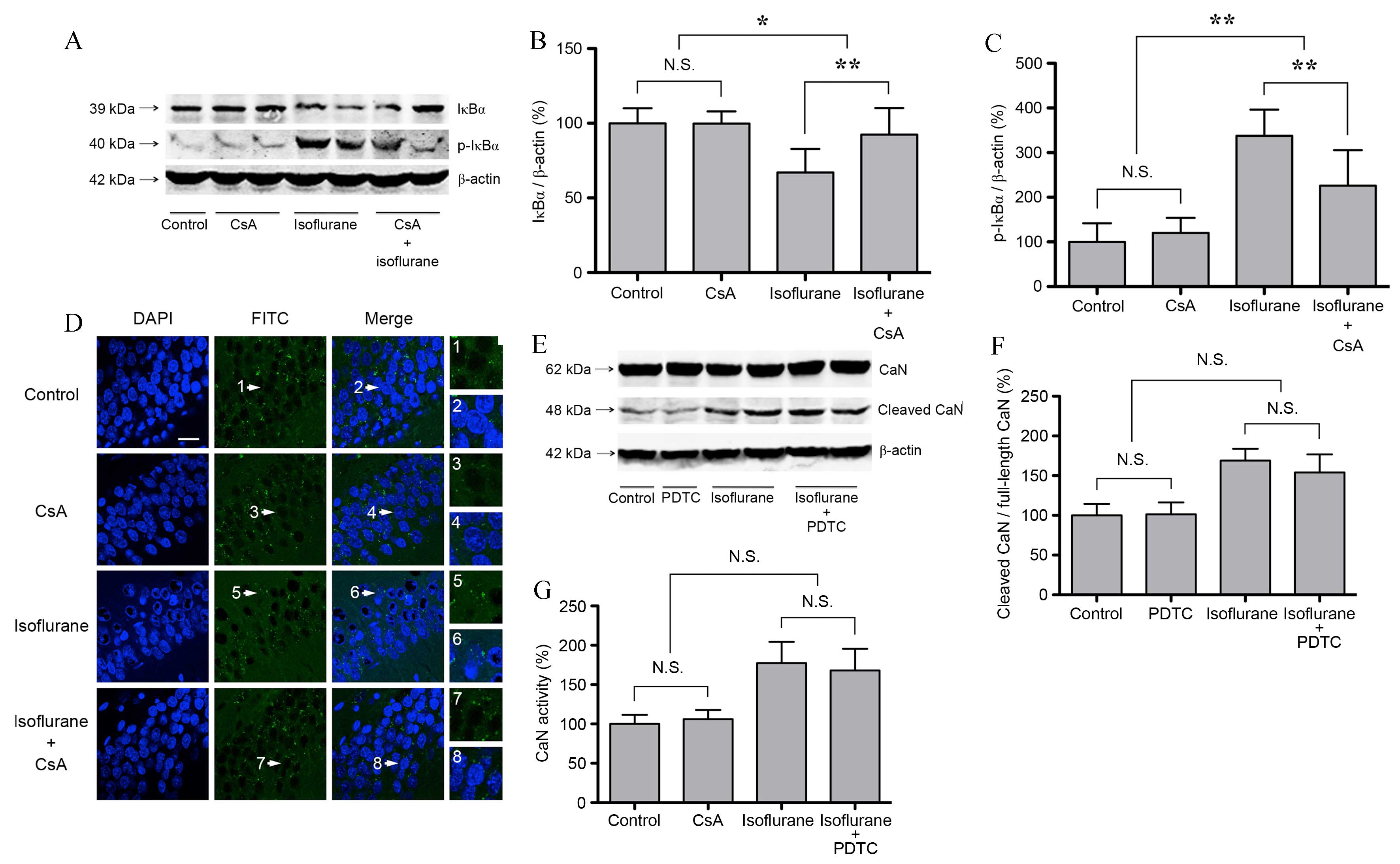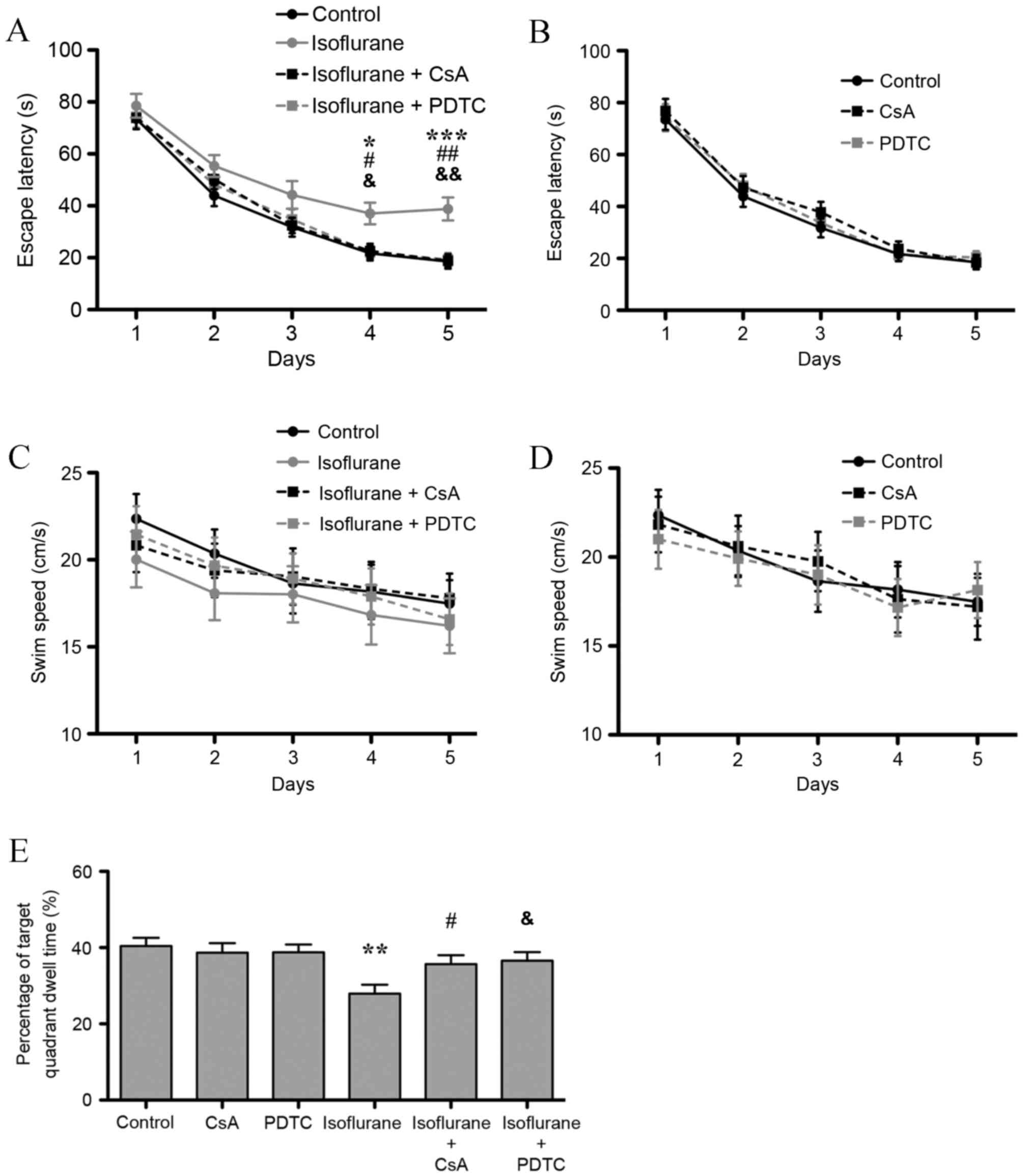|
1
|
Newman MF, Kirchner JL, Phillips-Bute B,
Gaver V, Grocott H, Jones RH, Mark DB, Reves JG and Blumenthal JA:
Neurological Outcome Research Group and the Cardiothoracic
Anesthesiology Research Endeavors Investigators: Longitudinal
assessment of neurocognitive function after coronary-artery bypass
surgery. N Engl J Med. 344:395–402. 2001. View Article : Google Scholar : PubMed/NCBI
|
|
2
|
Steinmetz J, Christensen KB, Lund T, Lohse
N and Rasmussen LS: ISPOCD Group: Long-term consequences of
postoperative cognitive dysfunction. Anesthesiology. 110:548–555.
2009. View Article : Google Scholar : PubMed/NCBI
|
|
3
|
Heneka MT and O'Banion MK: Inflammatory
processes in Alzheimer's disease. J Neuroimmunol. 184:69–91. 2007.
View Article : Google Scholar : PubMed/NCBI
|
|
4
|
Tan ZS, Beiser AS, Vasan RS, Roubenoff R,
Dinarello CA, Harris TB, Benjamin EJ, Au R, Kiel DP, Wolf PA and
Seshadri S: Inflammatory markers and the risk of Alzheimer disease:
The framingham study. Neurology. 68:1902–1908. 2007. View Article : Google Scholar : PubMed/NCBI
|
|
5
|
Li ZQ, Rong XY, Liu YJ, Ni C, Tian XS, Mo
N, Chui DH and Guo XY: Activation of the canonical nuclear
factor-κB pathway is involved in isoflurane-induced hippocampal
interleukin-1β elevation and the resultant cognitive deficits in
aged rats. Biochem Biophys Res Commun. 438:628–634. 2013.
View Article : Google Scholar : PubMed/NCBI
|
|
6
|
Xu Z, Dong Y, Wang H, Culley DJ,
Marcantonio ER, Crosby G, Tanzi RE, Zhang Y and Xie Z:
Age-dependent postoperative cognitive impairment and
Alzheimer-related neuropathology in mice. Sci Rep.
4:37662014.PubMed/NCBI
|
|
7
|
Wu X, Lu Y, Dong Y, Zhang G, Zhang Y, Xu
Z, Culley DJ, Crosby G, Marcantonio ER, Tanzi RE and Xie Z: The
inhalation anesthetic isoflurane increases levels of
proinflammatory TNF-α, IL-6, and IL-1β. Neurobiol Aging.
33:1364–1378. 2012. View Article : Google Scholar : PubMed/NCBI
|
|
8
|
Solberg NO, Chamberlin R, Vigil JR, Deck
LM, Heidrich JE, Brown DC, Brady CI, Jagt TA Vander, Garwood M,
Bisoffi M, et al: Optical and SPION-enhanced MR imaging shows that
trans-stilbene inhibitors of NF-κB concomitantly lower Alzheimer's
disease plaque formation and microglial activation in AbetaPP/PS-1
transgenic mouse brain. J Alzheimers Dis. 40:191–212.
2014.PubMed/NCBI
|
|
9
|
Liu T, Zhang T, Yu H, Shen H and Xia W:
Adjudin protects against cerebral ischemia reperfusion injury by
inhibition of neuroinflammation and blood-brain barrier disruption.
J Neuroinflammation. 11:1072014. View Article : Google Scholar : PubMed/NCBI
|
|
10
|
Guha M and Avadhani NG: Mitochondrial
retrograde signaling at the crossroads of tumor bioenergetics,
genetics and epigenetics. Mitochondrion. 13:577–591. 2013.
View Article : Google Scholar : PubMed/NCBI
|
|
11
|
Zhang Y, Xu Z, Wang H, Dong Y, Shi HN,
Culley DJ, Crosby G, Marcantonio ER, Tanzi RE and Xie Z:
Anesthetics isoflurane and desflurane differently affect
mitochondrial function, learning and memory. Ann Neurol.
71:687–698. 2012. View Article : Google Scholar : PubMed/NCBI
|
|
12
|
Rizzuto R, De Stefani D, Raffaello A and
Mammucari C: Mitochondria as sensors and regulators of calcium
signalling. Nat Rev Mol Cell Biol. 13:566–578. 2012. View Article : Google Scholar : PubMed/NCBI
|
|
13
|
Guha M, Srinivasan S, Biswas G and
Avadhani NG: Activation of a novel calcineurin-mediated
insulin-like growth factor-1 receptor pathway, altered metabolism,
and tumor cell invasion in cells subjected to mitochondrial
respiratory stress. J Biol Chem. 282:14536–14546. 2007. View Article : Google Scholar : PubMed/NCBI
|
|
14
|
Biswas G, Tang W, Sondheimer N, Guha M,
Bansal S and Avadhani NG: A distinctive physiological role for
IkappaBbeta in the propagation of mitochondrial respiratory stress
signaling. J Biol Chem. 283:12586–12594. 2008. View Article : Google Scholar : PubMed/NCBI
|
|
15
|
Wu X, Nguyen BC, Dziunycz P, Chang S,
Brooks Y, Lefort K, Hofbauer GF and Dotto GP: Opposing roles for
calcineurin and ATF3 in squamous skin cancer. Nature. 465:368–372.
2010. View Article : Google Scholar : PubMed/NCBI
|
|
16
|
Crack PJ, Taylor JM, Ali U, Mansell A and
Hertzog PJ: Potential contribution of NF-kappaB in neuronal cell
death in the glutathione peroxidase-1 knockout mouse in response to
ischemia-reperfusion injury. Stroke. 37:1533–1538. 2006. View Article : Google Scholar : PubMed/NCBI
|
|
17
|
Ni C, Tan G, Luo A, Qian M, Tang Y, Zhou
Y, Wang J, Li M, Zhang Y, Jia D, et al: Melatonin premedication
attenuates isoflurane anesthesia-induced β-amyloid generation and
cholinergic dysfunction in the hippocampus of aged rats. Int J
Neurosci. 123:213–220. 2013. View Article : Google Scholar : PubMed/NCBI
|
|
18
|
Whitlock JR, Heynen AJ, Shuler MG and Bear
MF: Learning induces long-term potentiation in the hippocampus.
Science. 313:1093–1097. 2006. View Article : Google Scholar : PubMed/NCBI
|
|
19
|
Frischbutter S, Gabriel C, Bendfeldt H,
Radbruch A and Baumgrass R: Dephosphorylation of Bcl-10 by
calcineurin is essential for canonical NF-κB activation in Th
cells. Eur J Immunol. 41:2349–2357. 2011. View Article : Google Scholar : PubMed/NCBI
|
|
20
|
Ferreiro DU and Komives EA: Molecular
mechanisms of system control of NF-kappaB signaling by
IkappaBalpha. Biochemistry. 49:1560–1567. 2010. View Article : Google Scholar : PubMed/NCBI
|
|
21
|
Rius J, Guma M, Schachtrup C, Akassoglou
K, Zinkernagel AS, Nizet V, Johnson RS, Haddad GG and Karin M:
NF-kappaB links innate immunity to the hypoxic response through
transcriptional regulation of HIF-1alpha. Nature. 453:807–811.
2008. View Article : Google Scholar : PubMed/NCBI
|
|
22
|
Lee W, Moon M, Kim HG, Lee TH and Oh MS:
Heat stress-induced memory impairment is associated with
neuroinflammation in mice. J Neuroinflammation. 12:1022015.
View Article : Google Scholar : PubMed/NCBI
|
|
23
|
Mirza MA, Ritzel R, Xu Y, McCullough LD
and Liu F: Sexually dimorphic outcomes and inflammatory responses
in hypoxic-ischemic encephalopathy. J Neuroinflammation. 12:322015.
View Article : Google Scholar : PubMed/NCBI
|
|
24
|
Williams GS, Boyman L, Chikando AC,
Khairallah RJ and Lederer WJ: Mitochondrial calcium uptake. Proc
Natl Acad Sci USA. 110:10479–10486. 2013. View Article : Google Scholar : PubMed/NCBI
|
|
25
|
Mallilankaraman K, Cardenas C, Doonan PJ,
Chandramoorthy HC, Irrinki KM, Golenár T, Csordás G, Madireddi P,
Yang J, Müller M, et al: MCUR1 is an essential component of
mitochondrial Ca2+ uptake that regulates cellular
metabolism. Nat Cell Biol. 14:1336–1343. 2012. View Article : Google Scholar : PubMed/NCBI
|
|
26
|
Duchen MR: Mitochondria and Ca(2+) in cell
physiology and pathophysiology. Cell calcium. 28:339–348. 2000.
View Article : Google Scholar : PubMed/NCBI
|
|
27
|
Yang H, Liang G, Hawkins BJ, Madesh M,
Pierwola A and Wei H: Inhalational anesthetics induce cell damage
by disruption of intracellular calcium homeostasis with different
potencies. Anesthesiology. 109:243–250. 2008. View Article : Google Scholar : PubMed/NCBI
|
|
28
|
Ni C, Li Z, Qian M, Zhou Y, Wang J and Guo
X: Isoflurane induced cognitive impairment in aged rats through
hippocampal calcineurin/NFAT signaling. Biochem Biophys Res Commun.
460:889–895. 2015. View Article : Google Scholar : PubMed/NCBI
|
|
29
|
Bakkar N, Ladner K, Canan BD,
Liyanarachchi S, Bal NC, Pant M, Periasamy M, Li Q, Janssen PM and
Guttridge DC: IKKα and alternative NF-αB regulate PGC-1β to promote
oxidative muscle metabolism. J Cell Biol. 196:497–511. 2012.
View Article : Google Scholar : PubMed/NCBI
|
|
30
|
Crampton SJ and O'Keeffe GW: NF-κB:
Emerging roles in hippocampal development and function. Int J
Biochem Cell Biol. 45:1821–1824. 2013. View Article : Google Scholar : PubMed/NCBI
|
|
31
|
Camandola S and Mattson MP: NF-kappa B as
a therapeutic target in neurodegenerative diseases. Expert Opin
Ther Targets. 11:123–132. 2007. View Article : Google Scholar : PubMed/NCBI
|
|
32
|
de la Fuente V, Federman N, Fustiñana MS,
Zalcman G and Romano A: Calcineurin phosphatase as a negative
regulator of fear memory in hippocampus: Control on nuclear
factor-κB signaling in consolidation and reconsolidation.
Hippocampus. 24:1549–1561. 2014. View Article : Google Scholar : PubMed/NCBI
|
|
33
|
Lim D, Iyer A, Ronco V, Grolla AA,
Canonico PL, Aronica E and Genazzani AA: Amyloid beta deregulates
astroglial mGluR5-mediated calcium signaling via calcineurin and
Nf-kB. Glia. 61:1134–1145. 2013. View Article : Google Scholar : PubMed/NCBI
|
|
34
|
González-Guerrero C, Ocaña-Salceda C,
Berzal S, Carrasco S, Fernández-Fernández B, Cannata-Ortiz P, Egido
J, Ortiz A and Ramos AM: Calcineurin inhibitors recruit protein
kinases JAK2 and JNK, TLR signaling and the UPR to activate
NF-κB-mediated inflammatory responses in kidney tubular cells.
Toxicol Appl Pharmacol. 272:825–841. 2013. View Article : Google Scholar : PubMed/NCBI
|
|
35
|
Zheng L, Liu H, Wang P, Song W and Sun X:
Regulator of calcineurin 1 gene transcription is regulated by
nuclear factor-kappaB. Curr Alzheimer Res. 11:156–164. 2014.
View Article : Google Scholar : PubMed/NCBI
|
|
36
|
Gutierrez H, O'Keeffe GW, Gavaldà N,
Gallagher D and Davies AM: Nuclear factor kappa B signaling either
stimulates or inhibits neurite growth depending on the
phosphorylation status of p65/RelA. J Neurosci. 28:8246–8256. 2008.
View Article : Google Scholar : PubMed/NCBI
|
|
37
|
Inta I, Paxian S, Maegele I, Zhang W,
Pizzi M, Spano P, Sarnico I, Muhammad S, Herrmann O, Inta D, et al:
Bim and Noxa are candidates to mediate the deleterious effect of
the NF-kappa B subunit RelA in cerebral ischemia. J Neurosci.
26:12896–12903. 2006. View Article : Google Scholar : PubMed/NCBI
|
|
38
|
Zhang Y, Wei G, Di Z and Zhao Q:
miR-339-5p inhibits alcohol-induced brain inflammation through
regulating NF-κB pathway. Biochem Biophys Res Commun. 452:450–456.
2014. View Article : Google Scholar : PubMed/NCBI
|
|
39
|
Rafati DS, Geissler K, Johnson K, Unabia
G, Hulsebosch C, Nesic-Taylor O and Perez-Polo JR: Nuclear
factor-kappaB decoy amelioration of spinal cord injury-induced
inflammation and behavior outcomes. J Neurosci Res. 86:566–580.
2008. View Article : Google Scholar : PubMed/NCBI
|
|
40
|
Dong Y, Wu X, Xu Z, Zhang Y and Xie Z:
Anesthetic isoflurane increases phosphorylated tau levels mediated
by caspase activation and Aβ generation. PLoS One. 7:e393862012.
View Article : Google Scholar : PubMed/NCBI
|
|
41
|
Canellada A, Cano E, Sánchez-Ruiloba L,
Zafra F and Redondo JM: Calcium-dependent expression of TNF-alpha
in neural cells is mediated by the calcineurin/NFAT pathway. Mol
Cell Neurosci. 31:692–701. 2006. View Article : Google Scholar : PubMed/NCBI
|
|
42
|
Guha M, Tang W, Sondheimer N and Avadhani
NG: Role of calcineurin, hnRNPA2 and Akt in mitochondrial
respiratory stress-mediated transcription activation of nuclear
gene targets. Biochim Biophys Acta. 1797:1055–1065. 2010.
View Article : Google Scholar : PubMed/NCBI
|














